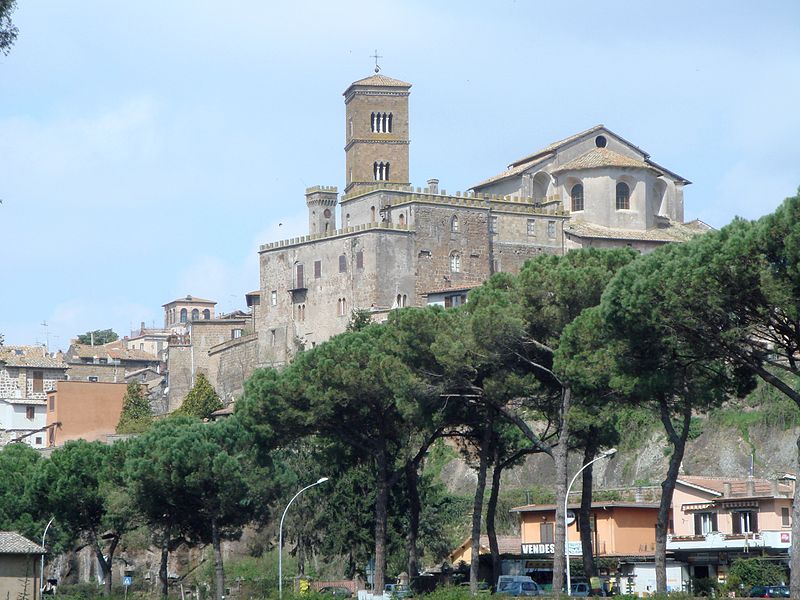by Br. Alexis Bugnolo
There is a lot of talk about the Pope resigning, being constrained to resign, or being deposed. So much so, that Reuters (a news agency founded by Jews and allied to Freemasonry) ran a story saying a Pope cannot be deposed.
This of course is a lie.
Let’s consider the question, then, “Can a Pope be deposed?” by first defining our terms. Here, “pope” means the Bishop of Rome, who ex officio is the Vicar of Christ and the Successor of Saint Peter.
By “deposed” there is meant removal from office.
The first determination we must make is to distinguish the auxiliary verb “can”. A thing can be done physically, morally and legally. An enemy of the Church could arrest the Pope, force him under pain of death to sign a decree of abdication. That is a physical deposition. A moral deposition, is where the Pope is asked to resign and he acquiesces and signs a decree of resignation. A legal deposition, would be where the Church by trial and in Synod or Council removes him from office.
Clerics can be canonically, that is legally, removed from office by their superiors, generally speaking. But since the Pope has no superior on earth, being the Vicar of Christ, many think he cannot be canonically removed from office.

That argument sounds valid on the face of it, but the Synod of Sutri in 1046 argues against it. In that Synod, which the Church to this day considers canonically valid, the Clergy of the Diocese of Rome, at the invitation of the German King, Henry III, met to decide the fate of Pope Benedict IX and two other anti-popes Gregory VI and Sylvester III. Gregory VI claimed the papacy on account of having bought it from Benedict IX; Sylvester III claimed it, having been elected after mobs drove Benedict IX from Rome. Neither were canonically elected, nor true popes, regardless of what some historians say, because to be pope you must be canonically elected after the death or resignation of your predecessor.
The events are summarized by John Cardinal Newman, and summarized in the Old Catholic Encyclopedia summarizes the events:
The proceedings of the Synod of Sutri, 20 December, are well summarized by Cardinal Newman in his “Essays Critical and Historical” (II, 262 sqq.). Of the three papal claimants, Benedict refused to appear; he was again summoned and afterwards pronounced deposed at Rome. Sylvester was “stripped of his sacerdotal rank and shut up in a monastery”. Gregory showed himself to be, if not an idiota, at least a man miræ simplicitatis, by explaining in straightforward speech his compact with Benedict, and he made no other defence than his good intentions, and deposed himself (Watterich, Vitæ Rom. Pont., I, 76); an act by some interpreted as a voluntary resignation, by others (Hefele), in keeping with the contemporary annals, as a deposition by the synod. The Synod of Sutri adjourned to meet again in Rome 23 and 24 December. Benedict, failing to appear, was condemned and deposed in contumaciam, and the papal chair was declared vacant. As King Henry was not yet crowned emperor, he had no canonical right to take part in the new election; but the Romans had no candidate to propose and begged the monarch to suggest a worthy subject.
Thus, The Synod deposed all three claimants to the papacy.* Gregory VI admitted his claim to the office was “vitiated” by simony. Pope Benedict IX objected, but the Church has always accepted his deposition as valid. The King of Germany then appointed Clement II as Pope, who promptly crowned the King, Holy Roman Emperor. Benedict IX, after the death of Clement, claimed the papacy again! The Church to this day recognizes Clement II as a true Pope.
That seems to run in the face of the current Code of Canon Law which expressly says a pope’s resignation cannot be forced and must be free. The relevant Canon is 332, which reads in Latin:
Can. 332 — 2. Si contingat ut Romanus Pontifex muneri suo renuntiet, ad validitatem requiritur ut renuntiatio libere fiat et rite manifestetur, non vero ut a quopiam acceptetur.
And in the official English translation:
Can. 332 — § 2. If it happens that the Roman Pontiff resigns his office, it is required for validity that the resignation is made freely and properly manifested but not that it is accepted by anyone.

But from this canon, its obvious, that there is no definition of the freedom required. Thus, just as a man freely resigns by an act which separates himself from the office, as Pope Benedict XVI intended to do, so a man can freely resign by acting in a manner so contrary to the office and the good of the Church, that he no longer wishes to act according to its duties.
Some argue, that since a thousand years have passed, and since we now have a College of Cardinals who elects the Pope, that a pope cannot be deposed like Benedict IX was.
But such an inference, which is by no means supported by anything but conjecture, assumes that the principles which validated the Synod of Sutri are not valid today. I am talking about canonical and theological principles.
Let’s look at what they were:
- The Clergy of the Roman Church acting for the good of the Church
- Against a corrupt Pope, who was by all impartial observers, unfit for the office.
- With the patronage of Henry II, King of the Germans.
I think all can agree, that though Henry II’s intention was Church reform, that his motives were not pure, since He had come to Italy to be crowned Holy Roman Emperor, a thing which only a Pope could grant him, and either Benedict IX would not grant it, or he was of such a degraded morality, that Henry II did not want to receive the crown from him.

Nevertheless, Henry II proceeded by canonical grounds: He convened the clergy of the Church of Rome, whose good was immediately threatened by Benedict IX. The Synod was called by Gregory VI, but deposed all three Popes. Benedict IX objected, but the Church accepted the results of the Synod, inasmuch as it recognizes as canonical the election of Clement II which followed immediately.
I think anyone who argues that the same could NOT be done today, therefore, has a very tenuous argument. He would have to argue that the form of canon 332 overrides the good of the entire Church, the good of the Diocese of Rome, and that it is more authoritative than the canonical precedent of the Synod of Sutri, which for the last 1000 years the Church has considered just and valid in all which it did. Indeed, the fact that Saint Hildebrand, later the great reforming pope, Gregory VII, attended this Synod and accepted its decisions to depose all three popes, argues strongly for its validity. Saint Peter Damnian, though there is no record that he attended, was in Rome the day after the Synod concluded and accepted its judgement. Pope Blessed Victor III also wrote about the Synod and accepted its judgments.
I for one think any opinion in law which has as its authority 1000 years of Church witness, 2 Canonized Saint Reformers, and 2 holy Popes, is much stronger than any interpretation of a canon which appears intended only for enemies of the Church. Especially since, Benedict IX does not seem to have accepted his deposition, yet is regarded by the Church and historians to have been validly deposed.
But, for those who love the Church, its obvious who the enemy is here.
NOTA BENE; For historical sources on the Synod of Sutri, look to the original sources and not to historians who were trying to make it appear, after the Council of Constance, that a Pope can never be deposed by anyone. And hold fast to the testimony of John Gratian (Gregory VI) at the Council of Sutri, who admitted his claim to the papacy was vitiated by the objective crime of simony. That Saint Hildebrand took the name of Gregory VII, to honor his patron John Gratian, proves nothing but his respect for the man and what he was trying to do (remove a bad Pope and begin a Reform), since in that age the numbers after a name did not prove or disprove the validity of the claim to the papacy. Those who attack the validity of the Synod of Sutri will run into crucial problems: if they accept Gregory VI as having a valid claim, they must recognize that he both convened the Synod and declared, therein, that his claim to the Papacy was invalid by reason of Simony; if they accept Benedict IX as having a valid claim, and deny the validity of his deposition, then how do they explain that Clement II is regarded by all subsequent Popes as canonically elected? The legitimacy of the Synod, therefore, must canonically be attributed to this, that it convened the Clergy of Rome to judge the man who was the Pope, not the Pope as Pope, so as to end all controversy as to who was pope and to put out of office all those who were morally unfit for office.
The Best Source we have found so far, besides that of Cardinal Newman, is the Dialogues of Blessed Pope Victor III, Patrologia Latina, vol. 149, columns 1004/5, which give the same history as above.
Finally, note, that in the Codex Iuris Canonicis of 1983, promulgated by John Paul II, in canon 188, it is explicitly stated that a resignation made by way of simony is invalid. Hence, it appears the Church never recognized as valid the resignation of Benedict IX, when he sold the papacy to Gregory VI. Which bolsters the argument, that Benedict IX’s deposition from the papacy by the Synod of Sutri, meeting at Rome in its second session, was indeed of epochal significance. A Pope can be deposed for immorality: for simony of his own office at least.
Veri Catholici, the international Association for protecting the faith from Kasperite heresies, is advocating calling a Synod like Sutri to depose Bergoglio, if he won’t resign. See vericatholici.wordpress.com for more information about that.)
______________________
* Synods which depose clerics are canonical trials, where the accusers and accused appear and are interrogated by the Tribunal, which includes senior clerics or all the clergy present. There is a libellus of accusations and testimonies are given. For this reason, there is no reason to call for an investigation in the matter of Viganò’s Letter of Accusation. What is needed is that the witnesses and accused appear and give their defense against what is charged. This is the Catholic and Legal way of ending the controversy.


Br. Bugnolo,
All of the evidence which proves that Bergoglio was, ipso facto, de facto, excommunicated (latae sentenciae) before the conclave, including all of the Cardinal-electors, is public. It’s all available online.
Why was this not taken into consideration by those within the apex of the church?
Bergoglio is not a legitimate superior of the church. He is a false pope. This is a fact. So, why would we desire him to renounce? He can do whatever he wants, as he is already accustomed to do as allowed by most catholics and clergy, especially within the apex of the church.